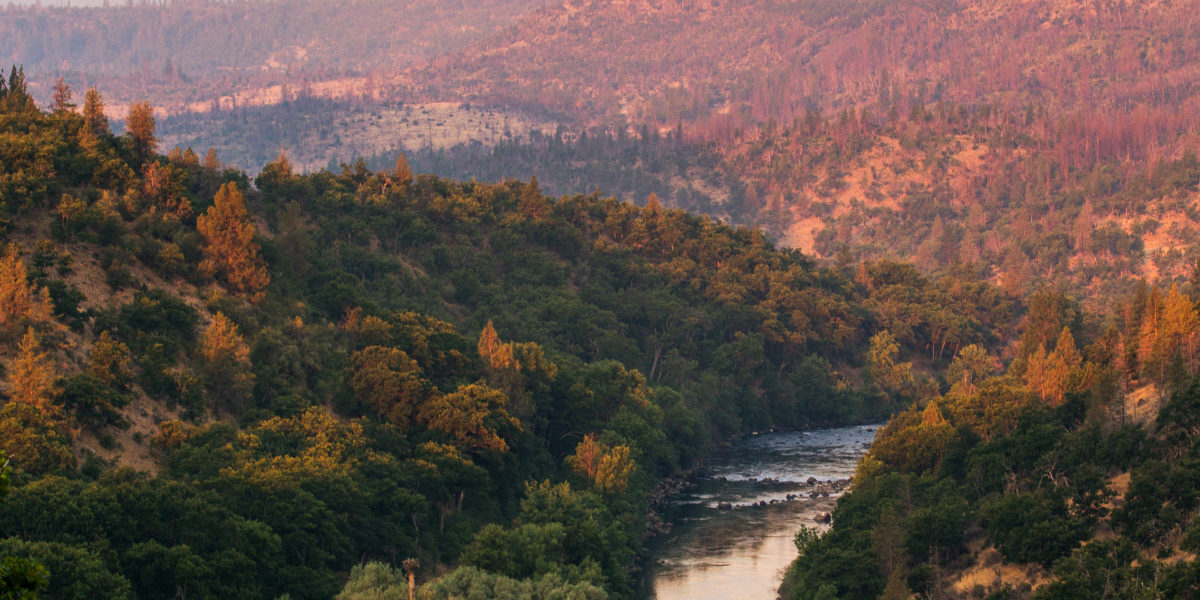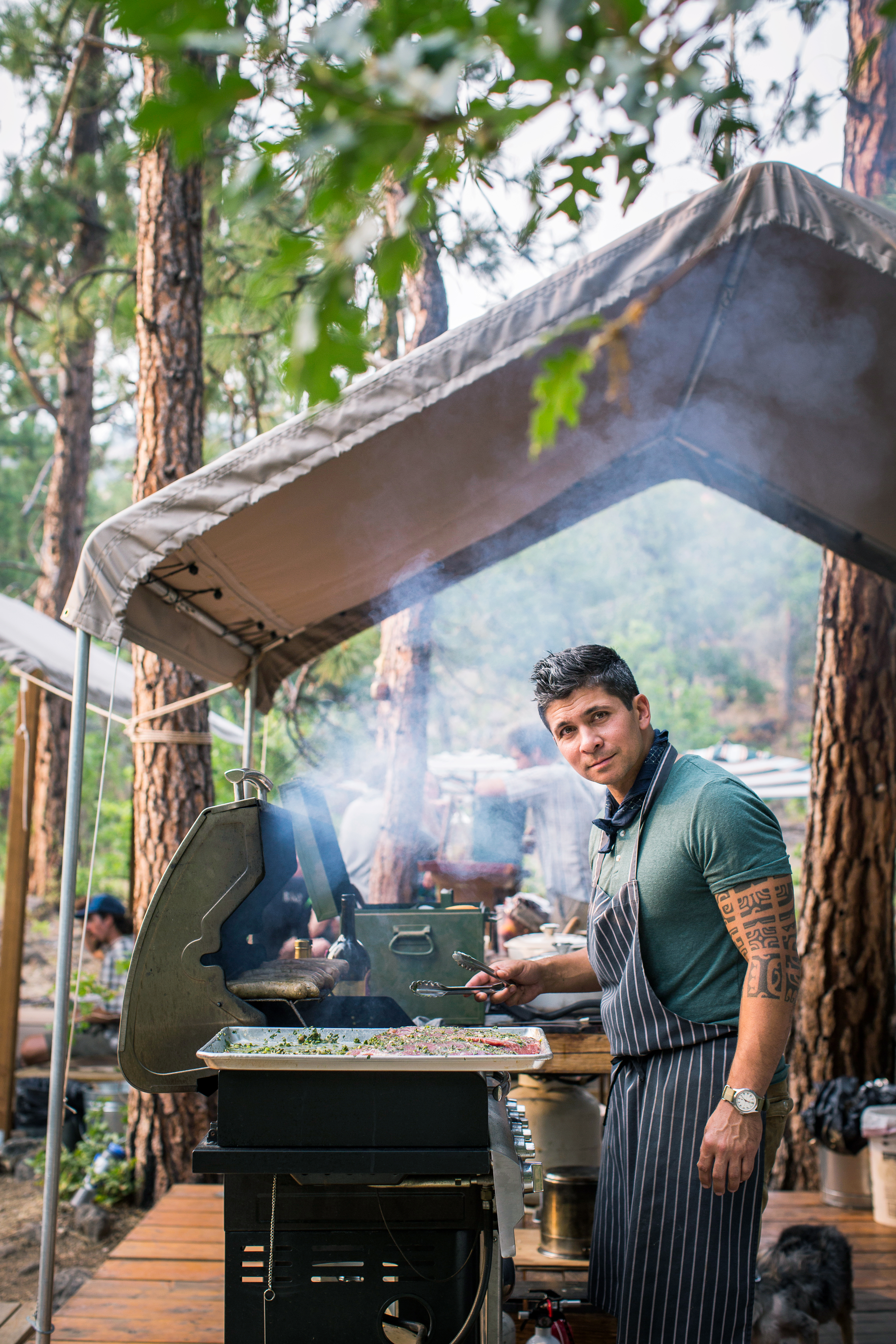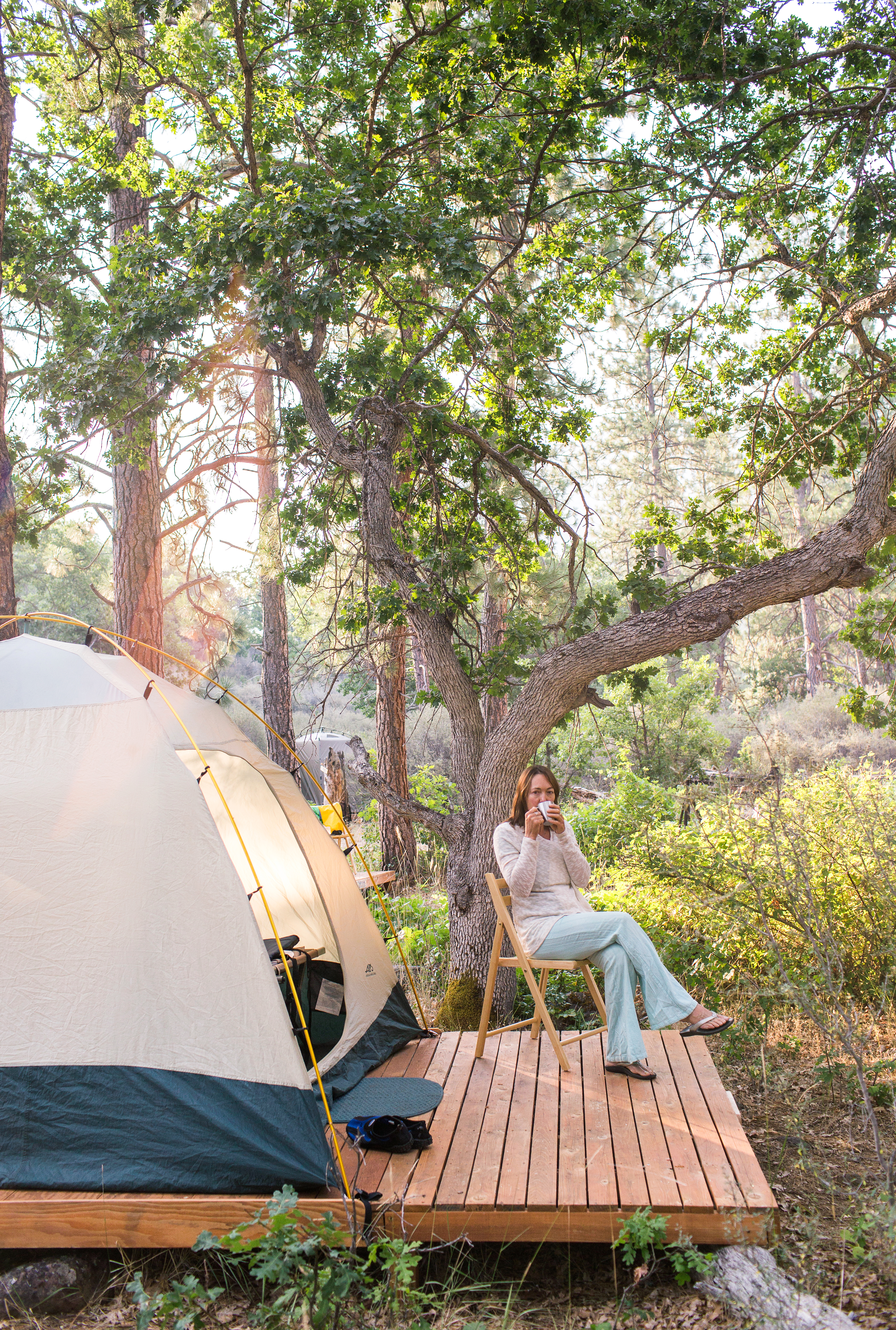
This Food-Fueled Oregon Rafting Trip Elevates Backcountry Cooking
Gourmet cuisine powers a rafting trip on Oregon’s Klamath River

I am halfway through my first single-origin mezcal margarita when the lightly charred street corn arrives on a platter at my umbrella-shaded Adirondack chair. Cotija cheese crumbles fall to the dirt at my flip-flopped feet as I dig in. That’s when the smell of chimichurri and smoke reaches me from the grill. Through the oak trees, the dark headwaters of the Klamath River flow past in a hush.
There are 14 guests scattered in similar forms of cocktail-hour repose under the oaks. After the last street corn kernels are pinched from the platter, we take seats at the long table under a shade tent. The feast arrives: flank steak, chicken thighs, Oaxacan mole-braised shell beans, cilantro- scented rice, and a salad of pickled onions, radish, cucumber, and cilantro dressing.
It’s a confusing confluence of the senses: the fresh air of wilderness mingling with the tastes and scents of the grill. Such is life (for three days, at least) on a new gourmet river-rafting trip along the Oregon-California border ($1,335/3-day trip).
There’s something enchanting about the incessancy of a river. I’ve spent months of my life floating down rivers, from lazy ones in the Deep South to hyperactive western whitewater. I’m drawn to the natural beauty of rivers and to “river time,” the calm that comes with relinquishing your pace to the flow. The food part has long been an afterthought. The Upper Klamath River trip, organized by Pete Wallstrom of Ashland, Oregon’s Momentum River Expeditions, promised to bring locally sourced urban gourmet meals to the riverside backcountry. I considered the trip a chance to step up my culinary game while on river time.
Ashland is a river-rafting hub, with a handful of legendary whitewater rivers within a short drive. Old school buses lean through the streets hauling trailers piled high with rubber rafts. Wallstrom, 44, fits the part of a river guide—tan, scruffy beard, Peter Pan bounce to his step. But Wallstrom wanted to distinguish himself in the crowded rafting world in two ways: establishing a glamping-style base camp along the Klamath, and bringing high cuisine to the table.
Each spring Wallstrom trucks in wood planks and tents and propane grills to this remote riverside camp. He erects three hot-water shower stalls, a dozen tent platforms, a dining room, kitchen, and, of course, a tiny bar. Wallstrom and I sat together at dinner on the first night talking about what he calls the Klamath water war. A coalition has formed around managing the Klamath Basin, he says. If it is implemented, a dam-removal project will be one of the most progressive river-restoration projects in the world.
“The more people that see a place, the more chance they’ll speak up to protect it,” Wallstrom tells me as we pile steak and mole beans onto our plates. “We did an informal poll and found that people want to be active, but comfortable—hot showers, a bathroom, and great food. That’s why we brought Matthew on this trip.”

Matthew Domingo, a baby-faced 39-year-old with a dapper urban style and a chatty kitchen presence, went to culinary school in Portland and worked in some of the city’s first-generation farm-to-table restaurants. He now prefers hauling his Le Creuset and Staub cookware into wild places.
“It’s bizarre cooking out here,” he says, as he preps veggies for tomorrow’s breakfast. “Figuring out what’s going to keep, organizing coolers. There are some limits, but it’s all about this, dude!” he says, stabbing his knife toward the river. “The kitchen window is nature!”
I press Domingo for his secrets, the tricks of the trade that give his food that sharp freshness.“First of all, I buy everything fresh and local,” he says. “Then I vacuum seal it. Sometimes I bring a Goal Zero solar-charged battery to power a food processor for beet or carrot purée. With meats, I often braise or slow-smoke them at home, then gently, artfully reheat them in a Le Creuset with wine and beef broth, maybe beer. After a few hours on simmer they’re falling apart but still smoky.”
“By the way, that’s what we’re having tomorrow—slow-smoked pork shoulder over creamy polenta,” he adds with a sly grin.Morning unfurls leisurely, without rush. The sun finally climbs over the valley rim around 8 a.m., about the same time folks emerge from their tents and tap into the fresh coffee. Bacon and frittata are already cooking in Domingo’s kitchen.

The river has dropped to a third of its flow overnight. It’s like low tide. For now, hydropower controls the Klamath, the magical incessancy reduced to a mechanical on-off switch. Around midmorning the turbines open and release a flume of dammed water. By 11 a.m. the river has risen to commercially runnable levels and the electricity flows throughout the Klamath region. It’s a reliable equation, but one that will change in a few years if the Klamath’s dams are removed.
After the hearty breakfast, all the guests pile into a raft and ferry to the opposite side of the river. Rather than packing up and continuing downriver to a second camp for night two, we’re going to return six miles upstream and meet the rafts (shuttled by van) for a second lap down the whitewater.
Most people opt to stretch their legs, following the road past broad meadows surrounded by oak and pine forests under a blue sky hazy from distant wildfire smoke.
After a riverside lunch of sandwiches, we don life jackets and helmets, grab our trusty paddles, and climb into position on our rafts. I glance at my raft-mates, Rebecca, a 30-year-old Brooklynite; and her mom, Karin. We’ve bonded after bouncing our way shoulder-to-paddling- shoulder down Class IV+ whitewater yesterday. They seem unfazed. Like many of the guests, they don’t appear to be hard-core river-runners, but they seem at ease. I’m a bit terrified.
The dark tea-colored water forms a smooth tongue and we accelerate into the froth of the quarter-mile-long Caldera Rapid. Mark, a grizzled, soft-spoken guide with decades of experience and his own commercial rafting outpost in Chile, calls for forward paddle strokes and we do our best to oblige, the 14-foot boat bucking like a slippery rubber bull. It’s chaos, but Mark deftly angles us past the SUV-size “mushroom rock” that’s eager to wrap our raft and dump us into the mayhem. We finally slide into a calm pool, spitting Klamath water from our mouths, high-fiving our paddles. The action continues for six more miles until we pull into our wilderness oasis for night two.
